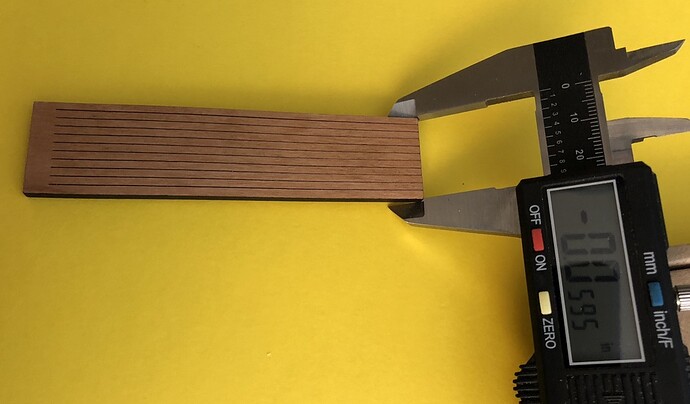This remains super helpful. Thanks for the tool and detailed explanation.
nice
Thank you, @BobV ! I’m looking forward to trying this out 
Sorry, I need this spelled out for me. What is the simple way to kerf? LOL
SO HELPFUL!!! Now that I have been stuck in a rabbit hole (since I only know what that is because of you guys) for hours on three different devices. You always know when I am in one because someone will say “Where is the iPad?” Followed by “where is the laptop?” and then “Do you have my phone?” because I find other possible rabbit holes that I don’t want to lose or forget about in the middle of one already created so I start grabbing devices! Ha
Here’s the one I use, which doesn’t have any loose pieces. Zero the caliper on the solid end, then measure the comb end while pressing the comb teeth together. Divide by 10.
This method can only measure the narrowest part of the kerf, but that’s what you usually want anyway, in situations where cut pieces will be pressed against each other.
Size the piece to be approximately 1" x 4" (exact dimensions don’t matter; it just has to be long enough that the teeth can be pinched together).
Genius. Probably less accurate than the one where you have pieces and you flip every other piece, but I haven’t ever found that much accuracy necessary.
So do you make one of these out of each material you use? I’m confused. Because otherwise wouldn’t the kerf always be the same? (You’d think I’d know more about this by now, but I still don’t!)
Kerf will be similar but not identical across materials of the same depth - but if you’re looking for exact you’ll need to do one of those out of each piece of material, or at least one piece of each type of material.
First, yes, each material. For example, I just measured 1/8" cherry plywood kerf as 0.0047", while 1/4" green acrylic kerf was 0.0055". This is on an almost-new machine.
From what I understand, it can also depend on:
- Your particular machine, how well calibrated the focus is, how dirty the lens is, etc…
- Cutting speed and power
- Variations in the material; for example the grain of the wood (especially for lower-quality wood)
Gotcha! Thanks!
Great info. Thank you very much!
